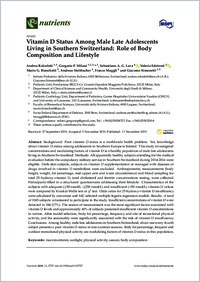Vitamin D status among male late adolescents living in southern Switzerland : role of body composition and lifestyle
- Rabufetti, Andrea Istituto Pediatrico della Svizzera Italiana, 6500 Bellinzona, Switzerland
- Milani, Gregorio P. Istituto Pediatrico della Svizzera Italiana, 6500 Bellinzona, Switzerland - Pediatric Unit, Fondazione IRCCS Ca’ Granda Ospedale Maggiore Policlinico, 20122 Milan, Italy - Department of Clinical Sciences and Community Health, Università degli Studi di Milano,20122 Milan, Italy
- Lava, Sebastiano A. G. Pediatric Cardiology Unit, Department of Pediatrics, Centre Hospitalier Universitaire Vaudois (CHUV), and University of Lausanne, 1011 Lausanne, Switzerland
- Edefonti, Valeria Department of Clinical Sciences and Community Health, Università degli Studi di Milano, 20122 Milan, Italy
- Bianchetti, Mario G. Faculty of Biomedical Sciences, Università della Svizzera italiana, Switzerland
- Stettbacher, Andreas Swiss Federal Department of Defence, 3000 Bern, Switzerland
- Muggli, Franco Swiss Federal Department of Defence, 3000 Bern, Switzerland
- Simonetti, Giacomo Istituto Pediatrico della Svizzera Italiana, 6500 Bellinzona, Switzerland - Faculty of Biomedical Sciences, Università della Svizzera Italiana, Switzerland
-
11.11.2019
Published in:
- Nutrients. - 2019, vol. 11, no. 11, p. 2727
English
Background: Poor vitamin D status is a worldwide health problem. Yet, knowledge about vitamin D status among adolescents in Southern Europe is limited. This study investigated concentrations and modulating factors of vitamin D in a healthy population of male late adolescents living in Southern Switzerland. Methods: All apparently healthy subjects attending for the medical evaluation before the compulsory military service in Southern Switzerland during 2014-2016 were eligible. Dark-skin subjects, subjects on vitamin D supplementation or managed with diseases or drugs involved in vitamin D metabolism were excluded. Anthropometric measurements (body height, weight, fat percentage, mid-upper arm and waist circumference) and blood sampling for total 25-hydroxy-vitamin D, total cholesterol and ferritin concentrations testing, were collected. Participants filled in a structured questionnaire addressing their lifestyle. Characteristics of the subjects with adequate (≥50 nmol/L–≤250 nmol/L) and insufficient (<50 nmol/L) vitamin D values were compared by Kruskal-Wallis test or χ2 test. Odds ratios for 25-hydroxy-vitamin D insufficiency were calculated by univariate and AIC-selected multiple logistic regression models. Results: A total of 1045 subjects volunteered to participate in the study. Insufficient concentrations of vitamin D were detected in 184 (17%). The season of measurement was the most significant factor associated with vitamin D levels and approximately 40% of subjects presented insucient vitamin D concentrations in winter. After model selection, body fat percentage, frequency and site of recreational physical activity, and the seasonality were significantly associated with the risk of vitamin D insufficiency. Conclusions: Among healthy male late adolescents in Southern Switzerland, about one every fourth subject presents a poor vitamin D status in non-summer seasons. Body fat percentage, frequent and outdoor recreational physical activity are modulating factors of vitamin D status in this population.
- Language
-
- English
- Classification
- Medicine
- License
- Open access status
- gold
- Identifiers
-
- RERO DOC 330386
- DOI 10.3390/nu11112727
- ARK ark:/12658/srd1319190
- Persistent URL
- https://n2t.net/ark:/12658/srd1319190
Statistics
Document views: 207
File downloads:
- Texte intégral: 238
